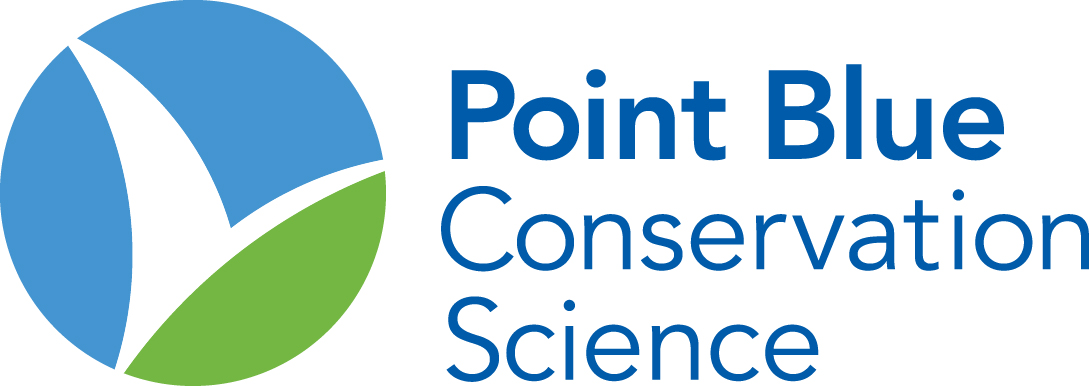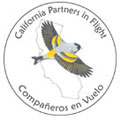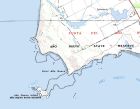|
|
The following interactive maps provide an exciting way to explore data about birds in and around California, and across the West. More than a printed map, you can zoom and pan, turn on and off data, and click on map features to find out more specific information.
|
Statewide
|
 Modeling of Bird Distribution Response to Climate Change
(2012)
Modeling of Bird Distribution Response to Climate Change
(2012)
(GIS Application)
UPDATE (2021-12-14): This resource has reached its end of life
(EOL) and is no longer available for access. Some original data can still be
accessed at:
https://data.pointblue.org/apps/ecn/data.php
Using climate models and multi-source bird data from
the Avian Knowledge Network, these maps display predictions for the current and future distributions for nearly 200 species in 7 habitat types found within California including: riparian, oak woodland, scrub, conifer, grassland, wetlands, and desert habitat types.
|
 Sierra Nevada Avian Monitoring Information Network
(2010)
Sierra Nevada Avian Monitoring Information Network
(2010)
(GIS Application)
The Sierra Nevada Avian Monitoring Information project aims to conduct distribution population monitoring of four management indicator species (MIS) in order to track changes in their distributions at the Sierra Nevada scale by monitoring the changesin their occurrence across a number of sample locations.
|
 Map-Based Access to Avian Data Summaries
(2009)
Map-Based Access to Avian Data Summaries
(2009)
(GIS Application)
 Interactive map providing species lists, counts, and other summary statistics for avian data hosted by CADC, including Breeding Bird Survey (BBS) routes, eBird locations, PRBO and partner organization study areas. The map allows exploration of landbird count and banding data, shorebird surveys, and at-sea transect data. You can navigate using by county or Aududbon California Important Bird Areas. Interactive map providing species lists, counts, and other summary statistics for avian data hosted by CADC, including Breeding Bird Survey (BBS) routes, eBird locations, PRBO and partner organization study areas. The map allows exploration of landbird count and banding data, shorebird surveys, and at-sea transect data. You can navigate using by county or Aududbon California Important Bird Areas.
|
 Partners in Flight Maps
(2008)
Partners in Flight Maps
(2008)
(GIS Application)
 These are interactive maps showing all CalPIF collaborators' study areas contributed to date and detailed information for each focal species,
with live updates. One of the main goals of the California Partners In Flight (CalPIF)
Bird Conservation Plan endeavor is to document the health and status of
bird populations across the entire state. To this end, PRBO has
developed a database of CalPIF bird monitoring sites and served as a
repository for species breeding status information for the entire state. These are interactive maps showing all CalPIF collaborators' study areas contributed to date and detailed information for each focal species,
with live updates. One of the main goals of the California Partners In Flight (CalPIF)
Bird Conservation Plan endeavor is to document the health and status of
bird populations across the entire state. To this end, PRBO has
developed a database of CalPIF bird monitoring sites and served as a
repository for species breeding status information for the entire state.
|
 Atlas of Colonies of Inland-Breeding Seabirds in California
(2004)
Atlas of Colonies of Inland-Breeding Seabirds in California
(2004)
(GIS Application)
 This project was designed to document the current status and highlight the conservation needs in California of a group of seven species of colonial or semicolonial waterbirds: American White Pelican, Double-crested Cormorant, Ring-billed Gull, California Gull, Caspian Tern, Forster's Tern, and Black Tern. This project was designed to document the current status and highlight the conservation needs in California of a group of seven species of colonial or semicolonial waterbirds: American White Pelican, Double-crested Cormorant, Ring-billed Gull, California Gull, Caspian Tern, Forster's Tern, and Black Tern.
|
|
San Francisco Bay Area
|
 Future San Francisco Bay Tidal Marshes – a Climate Smart Planning Tool
(2011)
Future San Francisco Bay Tidal Marshes – a Climate Smart Planning Tool
(2011)
(GIS Application)
PRBO's "Future San Francisco Bay Tidal Marshes – a Climate Smart Planning Tool" projects changes for the entire SF Bay using a dynamic marsh accretion model. Side-by-side maps are displayed of the current and future tidal marsh distribution for SF Bay and users can select climate change scenarios, sediment supply assumptions, and choose which results to display. The models generating these maps
are the first to take into account the ability of marshes to accrete, or keep up with, rising sea levels, in the San Francisco Bay Estuary. It allows the users to view and query maps to evaluate how sea level rise may impact tidal marsh habitat and bird species distribution over the next 100 years.
|
 Cosco Busan Oil Spill Map
(2008)
Cosco Busan Oil Spill Map
(2008)
(GIS Application)
 This map shows the how the Cosco Busan Oil Spill hit four Important Bird Areas in the Bay Area -- Richardson Bay, Brooks Island, East Shore Wetlands, and Bolinas Lagoon. Important Bird Areas are critical habitat for one or more species of bird and are recognized as a key component of global bird and biodiversity conservation. The map, which uses data collected through November 11th 2008 by the Office of Spill Prevention and Response, depicts a conservative estimate of oiled shoreline. This map shows the how the Cosco Busan Oil Spill hit four Important Bird Areas in the Bay Area -- Richardson Bay, Brooks Island, East Shore Wetlands, and Bolinas Lagoon. Important Bird Areas are critical habitat for one or more species of bird and are recognized as a key component of global bird and biodiversity conservation. The map, which uses data collected through November 11th 2008 by the Office of Spill Prevention and Response, depicts a conservative estimate of oiled shoreline.
|
|
Central Valley
|
 Predicted Bird Species Distribution in Central Valley (LIP)
(2008)
Predicted Bird Species Distribution in Central Valley (LIP)
(2008)
(GIS Application)
 The development of sophisticated species distribution modeling techniques provides an opportunity to greatly improve the value of species occurrence data. Using statistical and machine learning approaches, point occurrence data can be related to GIS-based environmental data layers to generate robust, spatially continuous predictions of species occurrence. Our approach was to use a machine learning algorithm called Maxent to predict species distributions for a variety of species in California's Central Valley. The development of sophisticated species distribution modeling techniques provides an opportunity to greatly improve the value of species occurrence data. Using statistical and machine learning approaches, point occurrence data can be related to GIS-based environmental data layers to generate robust, spatially continuous predictions of species occurrence. Our approach was to use a machine learning algorithm called Maxent to predict species distributions for a variety of species in California's Central Valley.
|
|
Offshore
|
 Farallon Marine Bird and Mammal Distribution
(2008)
Farallon Marine Bird and Mammal Distribution
(2008)
(GIS Application)
 This is an "atlas of maps", for selected bird and mammal species, giving you a picture of our PRBO's data collected during ocean surveys by boat from 2004-2006. It's a way of locating where birds and mammals are concentrating on and around the Farallon Islands, to help us understand the most important feeding areas for these animals. This atlas of maps is meant to be a resource for policy advisors, scientists, stakeholders, and the public interested in learning how marine birds and mammals concentrate on and around the Farallones. This is an "atlas of maps", for selected bird and mammal species, giving you a picture of our PRBO's data collected during ocean surveys by boat from 2004-2006. It's a way of locating where birds and mammals are concentrating on and around the Farallon Islands, to help us understand the most important feeding areas for these animals. This atlas of maps is meant to be a resource for policy advisors, scientists, stakeholders, and the public interested in learning how marine birds and mammals concentrate on and around the Farallones.
|
|
Pacific Flyway
|
 Movement Patterns of Bar-tailed Godwits
(2008)
Movement Patterns of Bar-tailed Godwits
(2008)
(GIS Application)
 These are live, interactive maps showing current locations and movement patterns of Bar-tailed Godwits. To answer questions about how long-distance migrating shorebirds use the global landscape, biologists are safely attaching tracking devices to follow their movements. In 2007 and 2008, satellite tracking devices have been attached to Bar-tailed Godwits, Long-billed Curlews. In Summer 2007, Bristle-thighed Curlews were tagged in their breeding grounds of western Alaska. These are live, interactive maps showing current locations and movement patterns of Bar-tailed Godwits. To answer questions about how long-distance migrating shorebirds use the global landscape, biologists are safely attaching tracking devices to follow their movements. In 2007 and 2008, satellite tracking devices have been attached to Bar-tailed Godwits, Long-billed Curlews. In Summer 2007, Bristle-thighed Curlews were tagged in their breeding grounds of western Alaska.
|
 Movement Patterns of Bristle-thighed Curlew
(2008)
Movement Patterns of Bristle-thighed Curlew
(2008)
(GIS Application)
 These are live, interactive maps showing current locations and movement patterns of Bristle-thighed Curlews. To answer questions about how long-distance migrating shorebirds use the global landscape, biologists are safely attaching tracking devices to follow their movements. In 2007 and 2008, satellite tracking devices have been attached to Bar-tailed Godwits, Long-billed Curlews. In Summer 2007, Bristle-thighed Curlews were tagged in their breeding grounds of western Alaska. These are live, interactive maps showing current locations and movement patterns of Bristle-thighed Curlews. To answer questions about how long-distance migrating shorebirds use the global landscape, biologists are safely attaching tracking devices to follow their movements. In 2007 and 2008, satellite tracking devices have been attached to Bar-tailed Godwits, Long-billed Curlews. In Summer 2007, Bristle-thighed Curlews were tagged in their breeding grounds of western Alaska.
|
 Movement Patterns of Long-billed Curlew
(2008)
Movement Patterns of Long-billed Curlew
(2008)
(GIS Application)
 These are live, interactive maps showing current locations and movement patterns of Long-billed Curlews. To answer questions about how long-distance migrating shorebirds use the global landscape, biologists are safely attaching tracking devices to follow their movements. In 2007 and 2008, satellite tracking devices have been attached to Bar-tailed Godwits, Long-billed Curlews. In Summer 2007, Bristle-thighed Curlews were tagged in their breeding grounds of western Alaska. These are live, interactive maps showing current locations and movement patterns of Long-billed Curlews. To answer questions about how long-distance migrating shorebirds use the global landscape, biologists are safely attaching tracking devices to follow their movements. In 2007 and 2008, satellite tracking devices have been attached to Bar-tailed Godwits, Long-billed Curlews. In Summer 2007, Bristle-thighed Curlews were tagged in their breeding grounds of western Alaska.
|
|
Western US
|
 The Western Hummingbird Information Network
(2010)
The Western Hummingbird Information Network
(2010)
(GIS Application)
The Western Hummingbird Information Network (WHIN) is the home website of the WHP and is the clearinghouse for all information relative to hummingbirds and hummingbird conservation.
|
 Sagebrush Bird Conservation Network Study Areas Database
(2007)
Sagebrush Bird Conservation Network Study Areas Database
(2007)
(GIS Application)
 The Sagebrush Bird Conservation Network (http://www.sagebrushbird.org/) maintains an on-line mapping application illustrating data from their database
of study areas & the breeding status of birds at those areas. The Sagebrush Bird Conservation Network (http://www.sagebrushbird.org/) maintains an on-line mapping application illustrating data from their database
of study areas & the breeding status of birds at those areas.
|
|



 The Sagebrush Bird Conservation Network (
The Sagebrush Bird Conservation Network (